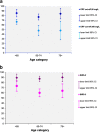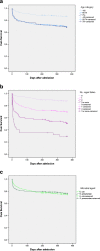Age-related differences in symptoms, diagnosis and prognosis of bacteremia
- PMID: 23883345
- PMCID: PMC3733624
- DOI: 10.1186/1471-2334-13-346
Age-related differences in symptoms, diagnosis and prognosis of bacteremia
Abstract
Background: Elderly patients are at particular risk for bacteremia and sepsis. Atypical presentation may complicate the diagnosis. We studied patients with bacteremia, in order to assess possible age-related effects on the clinical presentation and course of severe infections.
Methods: We reviewed the records of 680 patients hospitalized between 1994 and 2004. All patients were diagnosed with bacteremia, 450 caused by Escherichia coli and 230 by Streptococcus pneumoniae. Descriptive analyses were performed for three age groups (< 65 years, 65-84 years, ≥ 85 years). In multivariate analyses age was dichotomized (< 65, ≥ 65 years). Symptoms were categorized into atypical or typical. Prognostic sensitivity of CRP and SIRS in identifying early organ failure was studied at different cut-off values. Outcome variables were organ failure within one day after admission and in-hospital mortality.
Results: The higher age-groups more often presented atypical symptoms (p <0.001), decline in general health (p=0.029), and higher in-hospital mortality (p<0.001). The prognostic sensitivity of CRP did not differ between age groups, but in those ≥ 85 years the prognostic sensitivity of two SIRS criteria was lower than that of three criteria. Classical symptoms were protective for early organ failure (OR 0.67, 95% CI 0.45-0.99), and risk factors included; age ≥ 65 years (OR 1.65, 95% CI 1.09-2.49), comorbid illnesses (OR 1.19, 95% CI 1.02-1.40 per diagnosis), decline in general health (OR 2.28, 95% CI 1.58-3.27), tachycardia (OR 1.50, 95% CI 1.02-2.20), tachypnea (OR 3.86, 95% CI 2.64-5.66), and leukopenia (OR 4.16, 95% CI 1.59-10.91). Fever was protective for in-hospital mortality (OR 0.46, 95% CI 0.24-0.89), and risk factors included; age ≥ 65 years (OR 15.02, 95% CI 3.68-61.29), ≥ 1 comorbid illness (OR 2.61, 95% CI 1.11-6.14), bacteremia caused by S. pneumoniae (OR 2.79, 95% CI 1.43-5.46), leukopenia (OR 4.62, 95% CI 1.88-11.37), and number of early failing organs (OR 3.06, 95% CI 2.20-4.27 per failing organ).
Conclusions: Elderly patients with bacteremia more often present with atypical symptoms and reduced general health. The SIRS-criteria have poorer sensitivity for identifying organ failure in these patients. Advanced age, comorbidity, decline in general health, pneumococcal infection, and absence of classical symptoms are markers of a poor prognosis.
Figures


References
-
- Martin GS, Mannino DM, Moss M. The effect of age on the development and outcome of adult sepsis. Crit Care Med. 2006;34(1):15–21. doi: 10.1097/01.CCM.0000194535.82812.BA. - DOI - PubMed
MeSH terms
LinkOut - more resources
Full Text Sources
Other Literature Sources
Medical
Research Materials
Miscellaneous

